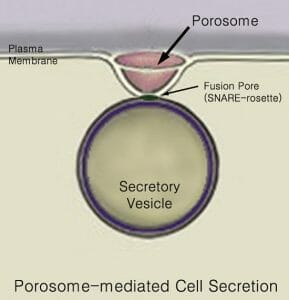Secretion Definition
Secretion refers to the methods used by organisms to actively move molecules manufactured within a cell to the space outside of the cell. These secreted substances are usually functional proteins, although they can be a diverse range of non-protein products, such as steroids. This process is in contrast to excretion, which involves removing waste products.
The Purpose of Secretion
Often, secreted substances act as short- or long-distance signals to another cell or tissue type. For examples, neurons secrete neurotransmitters to send a message to neighboring neurons, whereas the pituitary gland secretes several types of hormones that travel via the bloodstream to act throughout the body. These types of long-distance signals can have diverse functions, including on reproductive organs, kidney function, and metabolism.
In other cases, secreted substances play a crucial functional role within an organ or tissue type. In the stomach, for example, gastric glands contain three different cell types that secrete components of gastric acid. The mucous cells secrete lubricating mucus, parietal cells secrete hydrochloric acid, and chief cells secrete the precursor to the protein-digesting enzyme, pepsin. These all work in concert to break down food inside the stomach.
How Does Secretion Occur?
Secretion can occur via many pathways, depending on the cell type and the substance being transported. Ultimately, the secreted material must cross the cell membrane, or in some cases be inserted into the cell membrane. Some of the major secretory pathways are discussed below.
The ER-Golgi Pathway and Porosomes
In the traditional ER-Golgi pathway, secretory products are first produced in the endoplasmic reticulum (ER). They are then inserted into transport vesicles, which are spherical containers made up of a lipid bilayer. These then travel to the Golgi apparatus, where their contents are modified, marked for export, and packaged into specialized secretory vesicles—much like attaching a shipping label to a package and loading it into a delivery truck. The compartmentalization of the secretory pathway is important to keep proteins separate from the chemical environment in the cytosol, which can cause chemical reactions that change the structure and function of some proteins in undesirable ways.
After leaving the Golgi apparatus, secretory vesicles transport their cargo along the cytoskeleton to the cell membrane, where they interact with structures known as porosomes. These porosomes are conical-shaped fusion pores embedded in small pits in the cell membrane, with 3-4 porosomes per pit. After the vesicles dock, they swell, and the resulting pressure build-up aids in expelling their contents into the space outside of the cell. Porosome diameter is increased to allow the material in the vesicles to exit. Several different proteins form a fusion ring around the narrow portion of the porosome and are involved in fusing the vesicle membrane to the cell membrane to facilitate vesicle content release. Some of these proteins reside in the vesicle membrane and interact with proteins that make up a fusion ring around the base of the porosome. The process of using vesicles to move material from inside to outside the cell membrane is known as exocytosis. In some cell types, a specialized form of exocytosis is used. Neurons contain specific fusion proteins that allow rapid and synchronous neurotransmitter release to send a signal from one neuron to another.

In the image above, the vesicle transporting substances to be secreted fuses to the porosome in the cell membrane (also known as the plasma membrane).
Membrane Transporters
In some cases, proteins in the cytosol are moved across the cell membrane via transporter proteins instead of exocytosis. When this happens, they are not packaged in vesicles, but instead must be transported individually by specialized proteins in the cell membrane.
Lysosomes
Although lysosomes are organelles that are generally considered to be important for degradation, they also serve roles in secretion. In certain specialized cell types, the lysosomal secretory pathway is frequently used, including in pigment cells and blood stem cells. Much like secretary vesicles, lysosomes can fuse with the cell membrane to release their contents, although a different suite of proteins is used for the fusion process.
Secretion in prokaryotes
Prokaryotes, such as bacteria, lack membrane-bound organelles such as the ER and Golgi apparatus, but secretion can occur through many other pathways. For example, gram-negative bacteria use six different methods, labelled Types I-VI, all of which use unique molecular structures to move products across the cell membrane. Much of what bacteria actively secrete is harmful to other cells, and ongoing research into these secretory systems is useful for developing antibiotic treatments.
Quiz
1. What uses secretion?
A. Neurons
B. Bacteria
C. Glands
D. All of the above
2. Which region of a eukaryotic cell is NOT part of the ER-Golgi secretion pathway?
A. The endoplasmic reticulum
B. The Golgi apparatus
C. The cytosol
D. Vesicles
3. Which of the following is true about porosomes?
A. They produce proteins and package them into vesicles.
B. They interact with vesicles to release proteins from the cell.
C. They exist in vesicle walls.
D. None of the above.
References
- Reece, J.B., Urry, L.A., Cain, M.L., Wasserman, S.A., Minorsky, P.V., & Jackson, R.B. (2014). Campbell Biology (10th ed.). Boston, MA: Pearson Education, Inc.
